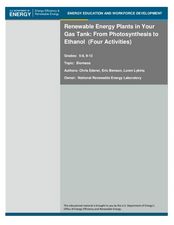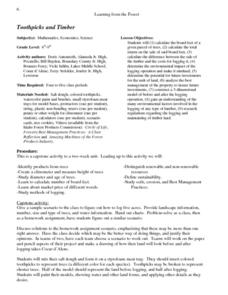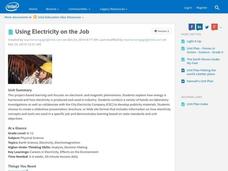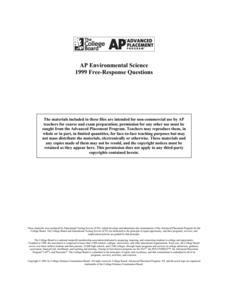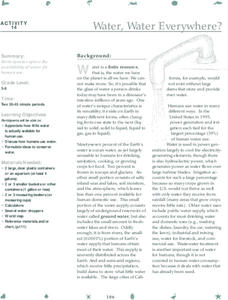Curated OER
Planet Zorcon
Students relate the geography and economics of Utah. In this geography lesson, students log their use of resources both natural and synthetic. Students participate in an experiment to understand how the Earth will be in the future if our...
Curated OER
Water Wars: Responsibility in the Age of Globalization
Learners explore the concept of water as a resource and as a human right. In this conservation instructional activity, students record and chart personal water usage and consumption then brainstorm ways in which to responsibly reduce...
Curated OER
Energy and Fuels
Students compare and contrast the various energy resources available to the general population. Working in groups, they research the energy source of their choice and create a presentation detail their research and comparing their...
Carnegie Mellon University
Hydroelectricity
Use a simple PowerPoint presentation to introduce you environmental studies class to hydropower. Hold a debate about the pros and cons of developing this form of alternative energy. Power up your class with this simple lesson on a topic...
Curated OER
Renewable Energy Plants in Your Gas Tank: From Photosynthesis to Ethanol
Students examine the role photosynthesis plays in plant survival. In this renewable energy lesson students document their observations and analyze and interpret their results.
Curated OER
Chemistry: Renewable and Nonrenewable Energy
Students research on renewable and nonrenewable resources. In this chemistry lesson, students design and build solar panels. They evaluate their device and write a lab report.
Curated OER
Solar Matters
Students design an energy resource wheel and demonstrate how to use it to access information about renewable and nonrenewable energy sources.
Curated OER
Toothpicks and Timber
Students problem-solve how to log five acres. Working in pairs, they construct models of logging sites before and after the trees are harvested. they paint their models and include other environmental details.
Intel
Using Electricity on the Job
Learners explore electricity, discussing its importance and researching different ways in which electricity can be generated. Groups present their findings to the class and then create publicity materials which promote and educate about...
Discovery Education
Wind Power
How do engineers turn something that is readily available, like wind, into energy? Scholars create a prototype of a wind turbine and attach it to a motor. They test out their prototypes and decide on their effectiveness. They also...
Kenan Fellows
Electricity: Sources, Usage, Challenges, and the Future
What does the future of energy look like? Junior engineers collaborate to discover a solution to the global energy crisis during a very hands-on lesson. The unit focuses on learning through collaboration to develop a deep understanding...
College Board
1999 AP® Environmental Science Free-Response Questions
Pollution is a real concern in most areas of Earth. A four-question AP® assessment has learners analyze data related to water pollution and air pollution as well as consider the pros and cons of recycling. Each question has several...
Wild BC
Greenhouse Gas Guzzlers
Teams of six to eight players imagine that they are driving in a vehicle and collect balls that represent carbon dioxide emissions based on their different activities. "Greenhouse Gas Guzzler" cards tell teams how many balls to collect...
Teach Engineering
Concentrated Solar Power
The seventh segment in an eight-part unit promotes the idea of concentrating the sun to increase the power of a photovoltaic panel. Pupils learn about devices used such as reflectors or lenses.
Magic of Physics
Franklin's Lab
Get energized! Circuitry scholars follow the path of energy from its beginnings as a fossil fuel all the way to bulbs and batteries using an interesting interactive. Groups or individuals help Ben Franklin discover how to convert and...
Teach Engineering
Organic Solar Energy and Berries
You can eat a solar cell? A unit on solar energy begins with a discussion about organic solar cells, followed by directions on how to build your own. After following the teacher's directions to build an anthocyanin...
Texas State Energy Conservation Office
Investigation: Building a Parabolic-Trough Collector
Amateurs of alternative energy build a mini parabolic-trough solar energy collector and use it to heat water. Temperature is recorded over a three-minute period and the data is graphed and analyzed. Note that in order to paint aquarium...
Art Institute of Chicago
Lesson Plan: A Writer’s Odyssey
Looking for a fresh approach to an end-of-unit project for The Odyssey? Check out a resource that has class members write their own hero's journey short story and then craft an illustration that depicts their tale. Apollonio di...
US Geological Survey
Water, Water, Everywhere?
Less than one percent of the earth's water is available for human use. A hands-on activity models the phenomenon for young scientists. Beginning with a specific volume of water, learners remove water that correlates to the percent of...
Virginia Department of Education
Succession
The final lesson in a two-part series prompts scholars to create newspaper articles and succession events. Applying their knowledge of the ecosystem and the past examples of succession, they predict what will happen in the future...
Curated OER
Energy Sources and Use
Students read and understand the importance of energy sources. In this Renewable and nonrenewable lesson plan, students read an article to become familiar with the uses of energy. Students read an article and answer questions...
Curated OER
Primary Energy Sources Pros and Cons
Students explore the different types of renewable and nonrenewable energy sources. In this earth science lesson, students discuss the pros and cons of each type. They conduct a variety of experiments on renewable energy.
Curated OER
Project Yellow Bus
Pupils discover the uses of energy and the difference between renewable and nonrenewable resources. They participate in hands-on activities to help them explain the concept of energy.
Curated OER
Project Yellow Bus
Students discover the uses of energy and the difference between renewable and nonrenewable resources. They participate in hands-on activities to help them explain the concept of energy.
Other popular searches
- Non Renewable Resources
- Non Renewable Resources
- Science Renewable Resources
- Grade 7 Renewable Resources
- Renewable Resources Wood
- Cookies Renewable Resources
- Renewable Resources Lab
- Ecology Renewable Resources
- Renewable Resources Lessons
- Renewable Resources Worksheets




